Road Marking Paints And Coatings Market Size and Trends
Global road marking paints and coatings market is estimated to be valued at USD 2,255.5 Mn in 2025 and is expected to reach USD 3,071.5 Mn by 2032, exhibiting a compound annual growth rate (CAGR) of 4.5% from 2025 to 2032.
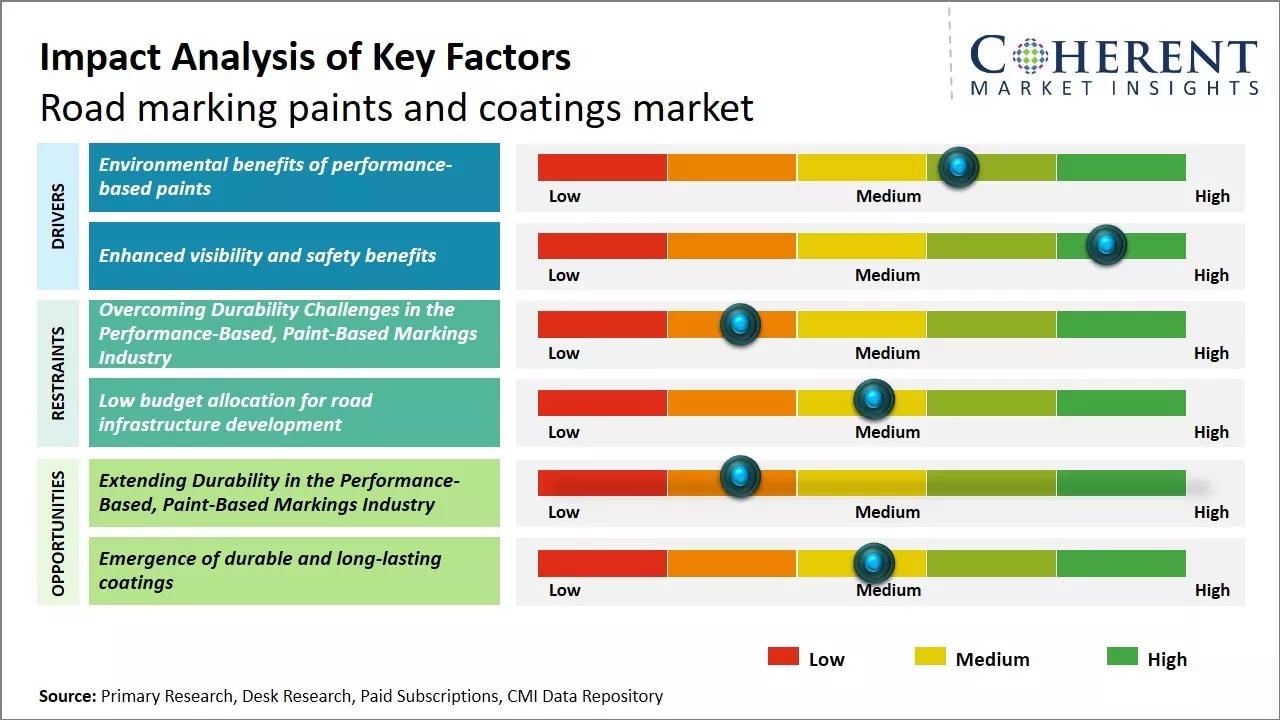
Discover market dynamics shaping the industry: Download Free Sample
This market includes various types of road surface markings and colors used to regulate traffic and provide important road safety information to drivers and pedestrians. The demand for performance-based, paint-based markings is expected to increase over the forecast period due to factors such as rising road infrastructure development projects, growing need for improving nighttime visibility of road markings, and increasing emphasis on traffic management and efficient guidance systems on roads. Traditionally, solvent-based road paints were used widely but regulations regarding VOC emissions are shifting focus to water-based and thermoplastic road markings.
Environmental benefits of performance-based paints
Performance-based paint-based markings offer significant environmental benefits over traditional paints used for road markings. These paints contain glass beads and other materials that allow the paint to remain visible under rain, snow, and other adverse weather conditions for a longer period of time as compared to traditional solvent-based paints. This means that performance-based paints does not need to be replaced as frequently. Since performance-based paints can last over two or three times longer than solvent-based traditional paints, this results in significantly less waste generation. By longer lasting on the roads, performance-based paints cut down on the frequency of road marking replacement cycles and the associated waste. This has a positive impact on the environment by reducing the carbon footprint of disposal and waste processing. Furthermore, performance-based paints contain lower amounts of volatile organic compounds (VOCs), which are greenhouse gases that contribute to global warming. Traditional paints release more VOCs into the atmosphere as these dry. Transitioning to newer performance-based technologies that reduce VOC emissions, agencies and municipalities can lower their environmental impact. This plays an important role in current policies around the world that are pushing for use of "Green Products". Products with environmentally sustainable attributes are increasingly favored by policymakers.
Market Concentration and Competitive Landscape
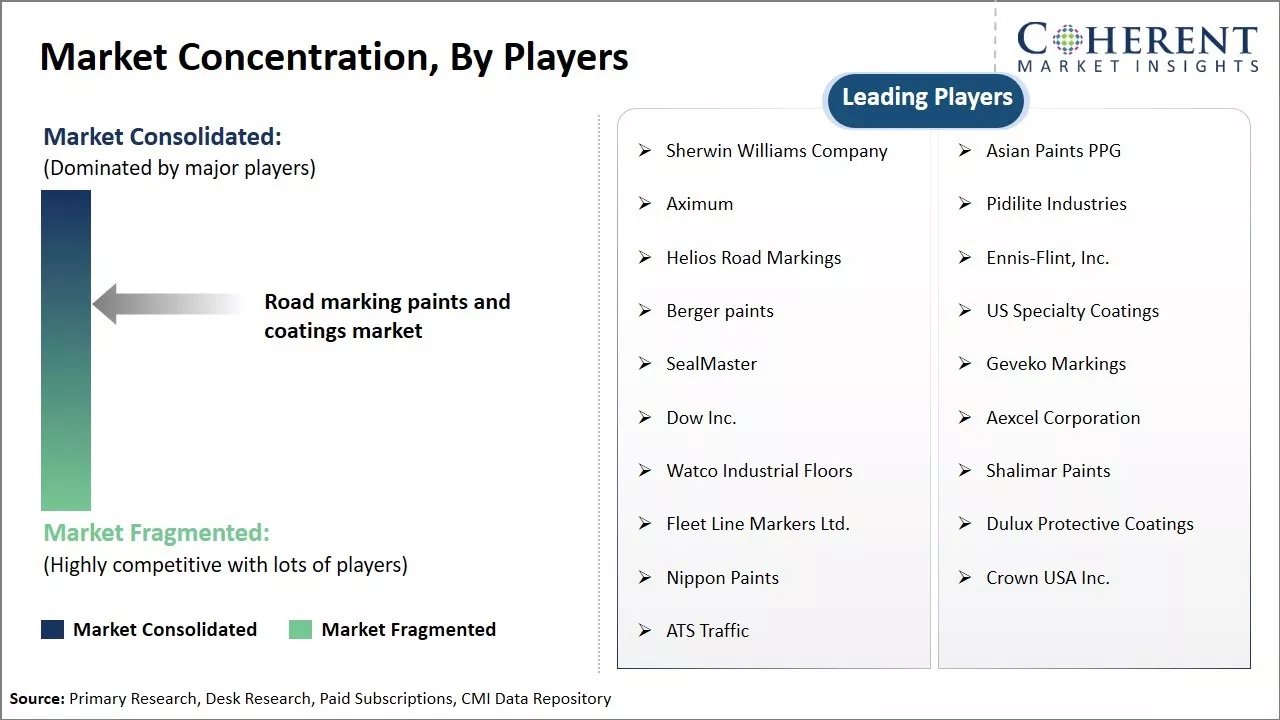
Get actionable strategies to beat competition: Download Free Sample
Enhanced visibility and safety benefitsPerformance-based paints provide a number of visibility and safety benefits over conventional paints used for road markings. These paints are formulated to maintain high retroreflectivity and visibility under all weather and lighting conditions including nighttime. As compared to other paints, performance-based varieties contain superior drop-on glass beads and additional retroreflective elements that ensure the markings remain clearly visible. Better visibility of road markings helps drivers navigate crowded roads safely and avoids accidents in low-light or rainy conditions. Studies show that higher retro reflectivity of markings allows drivers to perceive lane divisions, edges and other markings from longer distances, giving them more time to react to road conditions. This can significantly reduce the risk of head-on collisions or vehicles veering into the wrong lane unknowingly.
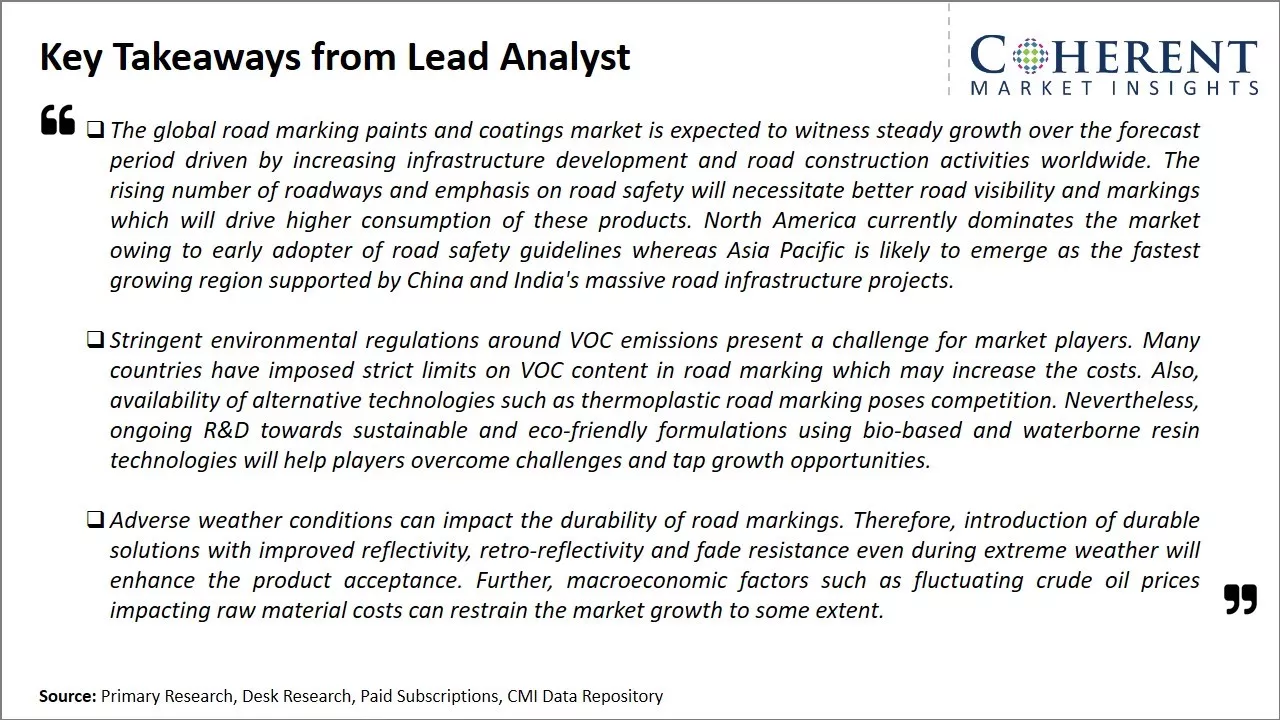
To learn more about this report, Download Free Sample
Market Challenges: Overcoming Durability Challenges in the Performance-Based, Paint-Based Markings IndustryOne of the key challenges faced by the performance-based, paint-based markings industry is the short durability of paint on roads and parking lots. Conventional paint needs to be reapplied every 6-12 months depending on weather conditions which leads to increased maintenance costs for cities and local governments. Additionally, regulations around the use of volatile organic compounds in paint formulations require manufacturers to constantly innovate to reduce VOC content without compromising durability, visibility, and slip resistance of their products.
Market Opportunities: Extending Durability in the Performance-Based, Paint-Based Markings Industry
The industry has strong opportunities for growth as cities and government agencies procure longer lasting products that require less frequent reapplication and result in lower total cost of ownership. Manufacturers developing paints using new resin technologies, ceramic particles and high quality pigments are extending the lifespan of traditional paint to 18-24 months.
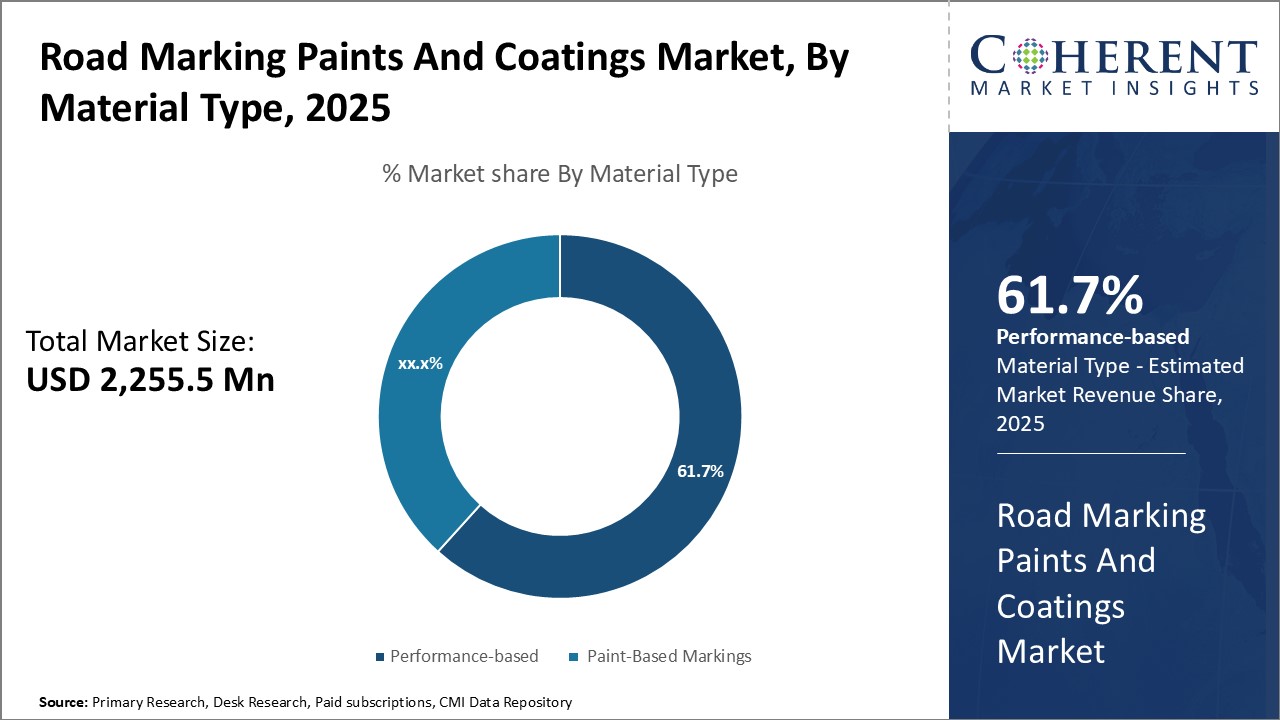
Discover high revenue pocket segments and roadmap to it: Download Free Sample
Insights, By Material Type: Durable Performance Drives Demand for material typeIn terms of material type, performance-based segment is estimated to contribute the 61.7% share of the market in 2025, owing to its long-lasting durability. Performance-based markings are engineered to withstand weathering from environmental factors like sun exposure, rain, snow, and salt on roads. These maintain high visibility for longer periods compared to other materials. This ensures clarity of road signs and markings even after months of use. The durable nature of performance-based markings helps reduce costs associated with frequent replacement and re-application of other temporary materials. The consistent brightness and reflectivity allows for safer driving conditions even in poor visibility. Contractors and manufacturers prefer performance-based markings due to less labor and time spent on maintenance and upkeep of markings. Overall, the extended lifespan and resistance to wear-and-tear has made performance-based markings the preferred choice where long-lasting visibility and guidance are critical safety priorities.
Insights, By Marking Type: Removability Maximizes Flexibility
In terms of marking type, permanent segment is estimated to contribute the 71.8% market share owing to advantages in convenient removability. This offers far greater flexibility to infrastructure managers compared to permanently adhered markings. Removable markings can be peeled off with specialized machinery when lanes need to be re-configured, redirected after construction work or road patterns change over time. The amenability to removal without residue allows for quick transitions and adaptability. Road crews and contractors appreciate the efficiency of removable products that does not require rigorous surface preparation for application or harsh chemical stripping for removal. The convenience transpires to lower installation and material costs versus semi-permanent or hard-to-remove permanent options. With simple removability, transportation agencies optimize road marking plans according to shifting needs while minimizing disruption and expenses from work-zone traffic control.
Insights, By Application: Expansive Reach Drives Traffic Safety
In terms of application, road and highway segment is estimated to contribute 41.8% market share owing to its role in overall traffic safety. Road/highway markings have the farthest reach in guiding drivers on expansive national, state, and municipal networks that see high traffic volumes. Clear lane markings, arrows, and words are crucial for navigation, merging, and direction on these busy thoroughfares. Well-marked roads directly contribute to traffic flow optimization and collision avoidance.
Regional Insights
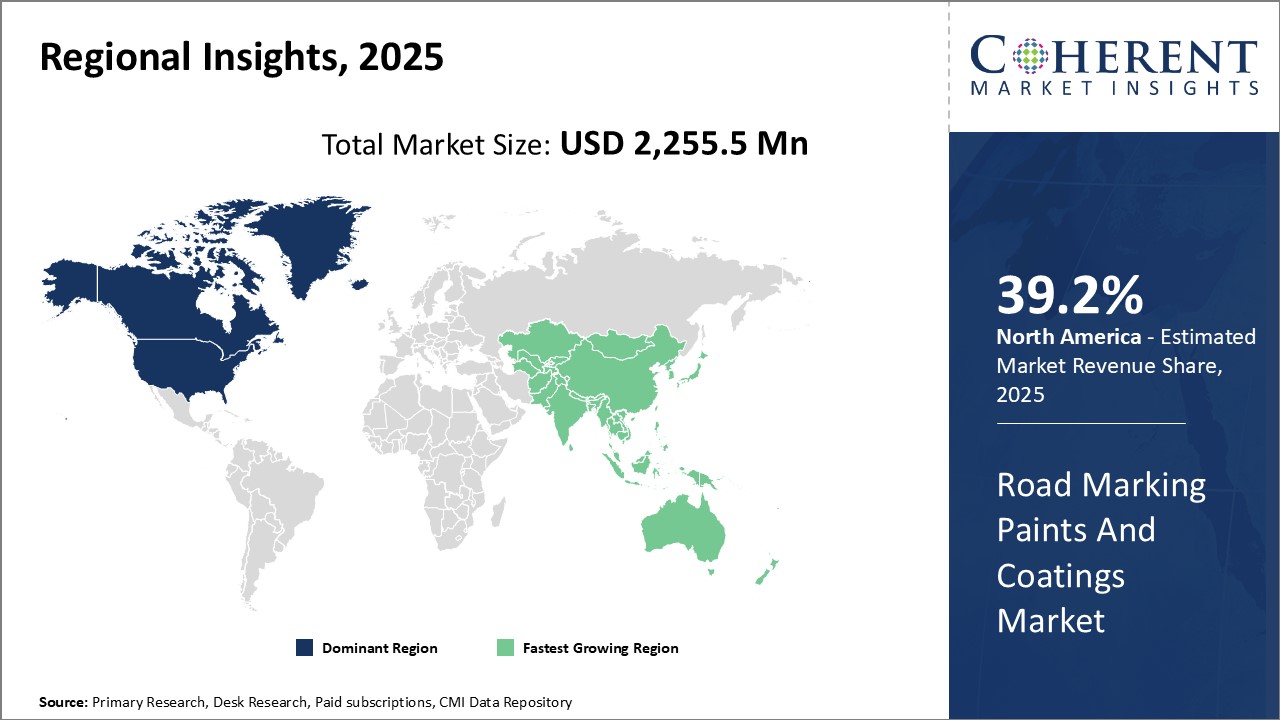
Need a Different Region or Segment? Download Free Sample
North America has been the dominant region in the road marking paints and coatings market for many years with estimated 39.2% market share in 2025. The well-established road infrastructure and strict norms regarding road safety in countries like the U.S. and Canada have created steady demand for these products. States like California and New York allocate high budgets for road maintenance and regularly deploy paint-based markings to clearly demarcate lanes, crossings and other road fixtures. Given the large road network and focus on driver safety, North American governments rely heavily on performance-based paints that last longer and provide clear visibility even in adverse weather conditions. Many global players also have their headquarters in North America, allowing them to cater to domestic requirements and export to other regions easily.
However, the Asia Pacific region is emerging as one of the fastest growing markets for road marking paints and coatings. Countries like China, India and Indonesia are undertaking massive road infrastructure development initiatives to boost connectivity and transportation facilities. As highway and expressway construction increases at a rapid pace, the requirement for long-lasting, high quality road paint is rising significantly. Local paint manufacturers are strengthening their R&D capabilities to match global product standards. Meanwhile, international suppliers are also enhancing their presence through collaborations or by establishing local manufacturing units to tap into the lucrative opportunities. Favorable business regulations and low production costs in several Asian nations attract major investments, helping the regional market garner momentum. The large population and rising purchasing power indicates the APAC demand for performance-based road paints will continue expanding at a brisk rate going forward.
Market Report Scope
Road Marking Paints And Coatings Market Report Coverage
| Report Coverage | Details | ||
|---|---|---|---|
| Base Year: | 2024 | Market Size in 2025: | USD 2,255.5 Mn |
| Historical Data for: | 2020 To 2024 | Forecast Period: | 2025 To 2032 |
| Forecast Period 2025 to 2032 CAGR: | 4.5% | 2032 Value Projection: | USD 3,071.5 Mn |
| Geographies covered: |
|
||
| Segments covered: |
|
||
| Companies covered: |
Sherwin Williams Company, Asian Paints PPG, Aximum, Pidilite Industries, Helios Road Markings, Ennis-Flint, Inc., Berger paints, US Specialty Coatings, SealMaster, Geveko Markings, Dow Inc., Aexcel Corporation, Watco Industrial Floors, Shalimar Paints, Fleet Line Markers Ltd., Dulux Protective Coatings, Nippon Paints, Crown USA Inc., ATS Traffic |
||
| Growth Drivers: |
|
||
| Restraints & Challenges: |
|
||
Uncover macros and micros vetted on 75+ parameters: Get instant access to report
Road Marking Paints And Coatings Industry News
- In August 2023, Sui Color developed a new product for its own line of All Paint paints: Vi-All, a 100% acrylic water-based road marking paint with very low volatile organic compounds (VOCs) and solvent-free. It does not pollute the environment.
- In January 2022 Geveko Markings was acquired and started operating with Oré Peinture, a France-based road marking paint and safety materials manufacturer.
- In February 2021, Dow launched its DURATRACKTM 2K Technology for large-area markings such as green bike lanes. Green bike lane coatings from Dow combine the sprayability and ease of use of a waterborne solution with the performance and durability of a two-component solution.
*Definition: Road marking paints and coatings are a type of road markings used to enhance visibility and safety on roadways. These use durable, retroreflective thermoplastic or preformed polymer materials to create durable markings that remain reflective even in wet conditions. Applied as lines, symbols or legends, these markings help guide drivers and increase nighttime visibility through rain, snow and other adverse conditions better than standard water-based paints.
Market Segmentation
- Material Type Insights (Revenue, USD Mn, 2020 - 2032)
- Performance-based
- Marking Tape
- Thermoplastics
- Cold Plastics
- Others
- Paint-Based Markings
- Solvent-borne Markings
- Water-borne Markings
- 2-Component Epoxy
- Others
- Performance-based
- Marking Type Insights (Revenue, USD Mn, 2020 - 2032)
- Permanent
- Removable
- Application Insights (Revenue, USD Mn, 2020 - 2032)
- Road and Highway Marking
- Pavement Marking
- Parking Lot Marking
- Factory Marking
- Airport Marking
- Field Marking
- Others
- Regional Insights (Revenue, USD Mn, 2020 - 2032)
- North America
- U.S.
- Canada
- Latin America
- Brazil
- Argentina
- Mexico
- Rest of Latin America
- Europe
- Germany
- U.K.
- Spain
- France
- Italy
- Russia
- Rest of Europe
- Asia Pacific
- China
- India
- Japan
- Australia
- South Korea
- ASEAN
- Rest of Asia Pacific
- Middle East & Africa
- GCC Countries
- Israel
- Rest of Middle East & Africa
- North America
- Key Players Insights
- Sherwin Williams Company
- Asian Paints PPG
- Aximum
- Pidilite Industries
- Helios Road Markings
- Ennis-Flint, Inc.
- Berger paints
- US Specialty Coatings
- SealMaster
- Geveko Markings
- Dow Inc.
- Aexcel Corporation
- Watco Industrial Floors
- Shalimar Paints
- Fleet Line Markers Ltd.
- Dulux Protective Coatings
- Nippon Paints
- Crown USA Inc.
- ATS Traffic
Share
Share
About Author
Yash Doshi is a Senior Management Consultant. He has 12+ years of experience in conducting research and handling consulting projects across verticals in APAC, EMEA, and the Americas.
He brings strong acumen in helping chemical companies navigate complex challenges and identify growth opportunities. He has deep expertise across the chemicals value chain, including commodity, specialty and fine chemicals, plastics and polymers, and petrochemicals. Yash is a sought-after speaker at industry conferences and contributes to various publications on topics related commodity, specialty and fine chemicals, plastics and polymers, and petrochemicals.
Missing comfort of reading report in your local language? Find your preferred language :
Transform your Strategy with Exclusive Trending Reports :
Frequently Asked Questions
EXISTING CLIENTELE
Joining thousands of companies around the world committed to making the Excellent Business Solutions.
View All Our Clients
